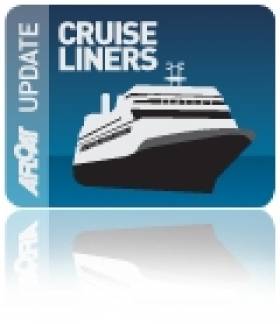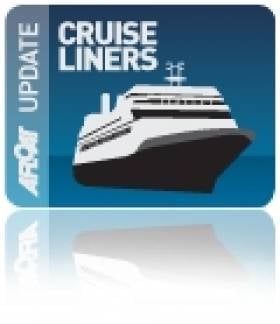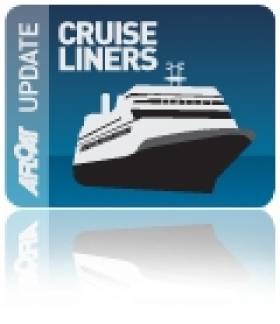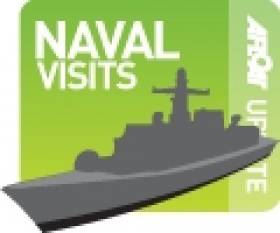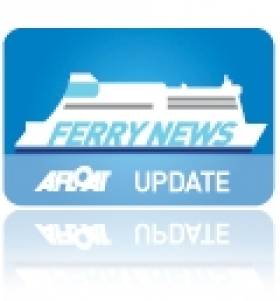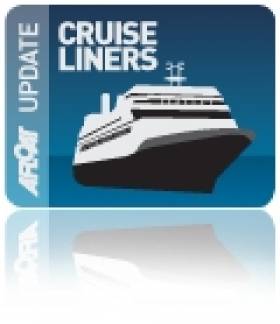Displaying items by tag: Dublin Port
Massive Cruise Liner Arrival Marks New Season for Dublin
#CRUISE–LINERS – The arrival of the €350 million Grand Princess cruise ship marked the opening of the 2012 Cruise season on Dublin Bay early this morning (Wed) when the 290 metre long vessel arrived overnight from Scotland on her only trip to Dublin this Summer.
The ship docked in Dublin Port is alongside for one night only and carries almost 4,000 high spend passengers and over 1,000 crew members.
During the winter the ship underwent an overhaul including the removal of part of her superstructure to save weight as Afloat previously reported here.
This year 90 cruise liners, 100,000 passengers contributing €35- €50m to the Dublin economy in 2012 will arrive into Dublin Bay. See the full list of Cruise calls to Dublin here.
The ship is the latest in cruise luxury with over 710 staterooms, an on-board shopping mall, cinema, a range of restaurant facilities, casino, swimming pools and a nine hole golf putting course.
The cruise sector has become a hugely important part of the city's tourism product since Dublin Port Company first targeted this trade in the mid 1990s.
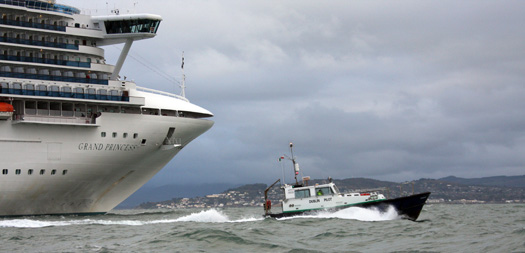
A Dublin Port Pilot vessel escorts the Grand Princess into Dublin Bay
The Port Company estimates that cruise liners have contributed over €350 million to the city in the last decade.
The Port Company first targeted this trade in the mid 1990s. It is estimated that cruise liners have contributed over €350 million to the city in the last decade alone so Dublin Port Company is pleased to have played its role in attracting this business for the city.
Dublin Port Company recently announced it will invest €110m over the next five years implementing projects under its Masterplan 2012-2040 for future development at Dublin Port. Among the major projects identified in the Masterplan is the construction of a new cruise facility adjacent to the east of the East Link Bridge to accommodate the growing number of passengers and cruise ships coming to Dublin each season, bringing high spending passengers and crew within easy reach of the Luas, city centre shops, eateries and attractions.

The Grand Princess passes Poolbeg light on her way up the river Liffey and into Dublin city
To progress the project, Dublin Port Company has formed Cruise Dublin, a joint initiative with Dublin City Council and Dublin Chamber of Commerce aimed at further developing the cruise tourism trade in Dublin. A study of the needs of the cruise industry and best practice elsewhere on how a suitable cruise terminal can be provided in Dublin is currently underway. The estimated cost of the development is €30 million. This study will be concluded later this month with a view to having a cruise terminal in place by 2015.
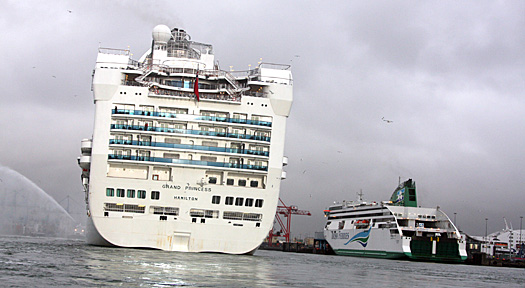
The 290 metre long cruise liner arrives at her berth dwarfing the Irish Ferries ship Ulysses
Mr. Eamonn O'Reilly, Chief Executive, Dublin Port Company said, "Dublin Port is already the largest gateway for cruise visitors to Ireland and with 1.7 million ferry passengers moving through the port, is behind only Dublin Airport and Cork Airport as a national tourism hub. We have a fantastic offering here with a growing reputation internationally as the go-to city for high end cruise calls. Our location at the heart of Dublin beside the city's shops, restaurants and bars, as well as proximity to the airport make Dublin Port a very attractive destination for major cruise liner operators. We're delighted to have secured 90 cruises for 2012 and with our new joint initiative, Cruise Dublin, committed to increasing this valuable trade for Dublin in the best way possible."
Meanwhile a new dock in the south of the bay has been installed at the Coal quay in Dun Laoghaire harbour ready for next week's first cruise ship arrival into Dun Laoghaire.
Read more about Cruise liners and cruise liner visits to Ireland
‘Lost Weight’ Cruiseship to Call to Dublin Port
#CRUISE LINERS – Following Friday's first cruise call to Dublin Port this year of the 300-plus passenger Arion as previously reported, the considerably larger Grand Princess is to call on Wednesday. Notably on this occasion the 2,600 passenger cruiseship is to appear without her signature 'Skywalker' Nightclub, which used to be perched 18 decks-high at the aft of the vessel, writes Jehan Ashmore.
The aptly named nightclub was built on two legs to form a bridge (see PHOTO) and was accessed by a glass gangway. Not only was the structure at such an elevated position but it also overhang beyond the sheer of the stern superstructure below, where clubbers had bird's eye views over the oceans and to numerous ports of calls.
In an operation to remove the Skywalker last year, the structure weighing 211 tons took over 10 hours to complete (as previously reported including VIDEO of the work). The reason for removing the nightclub according to her owners Princess Cruises was to 'significantly improve the operational performance of the ship, including greater fuel efficiency.' For a post dry-docking view click PHOTO.
During the procedure at the Grand Bahama Shipyard in the US, the opportunity included the installation of a new nightclub three decks below and was named One5.
Ironically before the vessel lost weight!....she was the first cruiseship to visit Dublin Port to surpass the 100,000 tonnes milestone, when the leadship of the 'Grand' class docked in 2004.
From Falmouth to the Fjords
#CRUISE LINERS – Dublin Port's first cruise caller for this season will be Arion which today sets sail from Falmouth on an eleven night / twelve day cruise to Scotland and Norwegian fjords. The 5,888 gross tonnes cruiseship built in 1965 is to berth in the capital at Ocean Pier, writes Jehan Ashmore.
The veteran vessel which has sleek traditional lines can carry over 300 passengers and she is operated by Classic International Cruises. Her visit will be one of around 90 cruise calls scheduled to Dublin Port during this year's season which stretches to early October. The majority of these calls will be in the summer and where several ships will be making repeat port of calls.
With so many callers to Dublin Port, this brings a greater variety of vessels as evident between the Arion and Princess Cruises considerably larger Grand Princess which is due next week. The giant vessel weighs over 109,000 gross tonnes and has a capacity for over 4,000 passenger and crew.
The Portuguese flagged Arion is also set to open the season to Galway, as previously reported she is to make an anchorage call off the mid-west harbour next month.
Meanwhile following all the recent focus centred in Cobh, Cruise & Maritime Voyages Marco Polo is expected to arrive this afternoon by berthing at the town's dedicated cruiseship quayside.
Minehunter that Served in Libya Anchors in Dublin Bay
#NAVAL ANCHORAGE – A Royal Navy mine-hunter HMS Bangor (MI09) which took part in Libyan operations last year, anchored overnight in Dublin Bay during the north-easterly gale force winds, writes Jehan Ashmore.
Unlike the majority of vessels which anchor in the south of the bay, she unusually took anchorage north of the main shipping lane for Dublin Port by positioning off Sutton South on Howth Peninsula.
HMS Bangor is a Sandown class mine-hunter and she is due to continue her northbound passage through the Irish Sea to spend Easter at her affiliated namesake town on the shores of Belfast Lough.
Her last call to Bangor was to celebrate Armed Forces Day 2010 and also in that year she called to Dublin, click HERE for that report.
On this occasion she will tell of her role supporting NATO operations off the coast of Libya. During Operation Unified Protector, the mine-hunter's task involved 120 days of non-stop action by scouring miles of sea bed off Libya as the battle between rebels and Colonel Gaddafi raged.
Built in 1999 by Vosper Thorneycroft, Southampton, the glass-reinforced plastic (GRP) ship and her 34 crew undertook the painstaking work. This paid off when the 55m vessel found a 2,400-pound (1000kg) mine and a torpedo lying on the seabed off the port of Tobruk in eastern Libya.
Both were safely destroyed using the ship's Sea Fox system – an underwater drone armed with explosive charges.
HMS Bangor is among seven of her class based at on the Clyde, Scotland. They each displace 600 tonnes and have a range of 2,500 nautical miles. For further details about the class, click HERE.
Father-Son Duo in Charity Paddle from Dublin to Donegal
#KAYAKING - A father-and-son duo from north Co Dublin will shortly embark on an epic kayak paddle from Dublin to Donegal, the Fingal Independent reports.
Dermot Higgins and his son Fionn, from Rush, will attempt to kayak from Dublin Port to the Atlantic Ocean at Ballyshannon - a distance of some 330km - by way of the Royal Canal, the River Shannon and Lough Erne.
The Higgins' - who believe they are the first to attempt such a feat - will be completely self-sufficuent for the duration of the challenge, which is hoped to raised funds for the Rush Open Organisation for Transition Status (ROOTS), a charity that intends to help communities reduce their carbon footprint and face up to environmental challenges by encouraging sustainability.
The Fingal Independent has more on the story HERE.
Sistership of Figaro Race ‘Guardship’ to Visit
#NAVAL VISIT – A sistership of the French Naval patrol vessel that performed 'guardship' duties during last year's La Solitaire du Figaro Race to Dun Laoghaire (click HERE), is due to dock in Dublin Port in advance of St. Patrick's weekend, writes Jehan Ashmore.
PSP Pluvier (P678) is a 54m offshore patrol vessel (OPV) that belongs to a trio of the'Flamant' class, the remaining pair are the leadship PSP Flamant (P676) and PSP Cormoran (P677). The latter OPV escorted the race fleet on the second leg between Ouistreham (Caen) to Dun Laoghaire, the only international port of call of the prestigious race.
The naval visitor is the last of the sisters built and was constructed in Cherbourg at Chantier des Constructions Mécaniques de Normandie (CMN). She entered service in 1997 and carries out patrols in seas up to 200 nautical miles offshore of the French économique exclusive zone (ZEE).
She is scheduled to arrive on Thursday afternoon and berth at Sir John Rogersons Quay, downriver from the Samuel Beckett swing-bridge.
Dublin Port Launches 30-year Masterplan
#DUBLIN PORT–Dublin Port Company will invest €110m from its own reserves over next five years in the Capital's port it was announced this morning when a long term master plan was unveiled. The final Masterplan is available for download below.
Port Chief Executive Eamon O'Reilly says the size of the port will remain the same for the next 10 years, but after that, expansion will be needed.
"We reckon we have enough of a footprint at the moment to last us for growth for about a decade or maybe even a bit more than that," Mr O'Reilly told the Irish Examiner.
Minister for Transport, Tourism and Sport Leo Vradkar launched Dublin Port Company's Masterplan 2012 to 2040 today. The plan sets out the framework for the long-term development of Ireland's largest and most important port. Implementing the plan will cost in excess of €600m over the next 30 years which will be financed from the company's own resources.
Dublin Port Company has already committed to investing €110m over the first five years of the Masterplan period.
The launch of the Masterplan follows a year-long consultation with business, community, industry and government stakeholders.

Launching Dublin Port Company's Masterplan 2012-2040, a framework for the long-term development of Dublin Port which will be financed from the company's own resources, were Minister for Transport, Mr. Leo Varadkar T.D., Mr. Eamonn O'Reilly, Chief Executive of Dublin Port Company, Ms. Lucy McCaffrey, Chairperson of Dublin Port Company and Dublin City Manager, Dr. John Tierney
Central to the Masterplan is ensuring Dublin Port's capacity to service Ireland's future import and export trading needs both efficiently and competitively. The Masterplan now provides Dublin Port Company and its stakeholders with a clear view as to how the port will be developed over the long-term.
In economic terms, it will mean Dublin Port Company will be ready to handle 60 million tonnes of goods by 2040, double its current throughput based on a modest assumed growth of 2.5% per annum.
The Masterplan is founded on three principles:
· Maximising the use of existing lands;
· Reintegrating the port with the city; and
· Developing the port to the highest environmental standards.
The Masterplan has clearly shown that Dublin Port will need to expand over the next 30 years. However, the port has some breathing space because of the economic downturn and can now cater for projected growth for a decade or more within its existing footprint. The initial investment under the Masterplan will be focussed on maximising the use of the port's existing capacity. Projects involving reclamation will only be advanced if and when they become necessary and if they can meet exacting planning and environmental protection standards.
Among the first projects that Dublin Port Company has identified to achieve its aims is the building of a dedicated car storage compound on a site between East Wall Road and the Dublin Port Tunnel. This facility would free up valuable quay-side space for port activity.
Another major initiative is the construction of a new cruise facility adjacent to the east of the East Link Bridge to accommodate over 135,000 passengers and almost 90 cruise liners each season. The company believes that the option identified in Dublin City Council's Cruise Tourism Local Action Plan of the North Quay extension would provide the optimum location for this, bringing high spending passengers and crew within easy reach of the Luas and city centre shops, eateries and attractions.
To progress this concept, Dublin Port Company has formed Cruise Dublin, a joint initiative with Dublin City Council and Dublin Chamber of Commerce aimed at further developing the cruise tourism trade in Dublin. The first step will be to undertake a study of the needs of the cruise industry and to learn from best practice elsewhere how a suitable cruise terminal can be provided in Dublin. The estimated cost of the development is €30 million. This study will be concluded later this year with a view to having a cruise terminal in place by 2015.
Integrating Dublin Port with Dublin city and its citizens is another core aim of the plan. In that context, improved walkways and cycle paths, public viewing platforms, the installation of maritime art displays and softer port boundaries are among the initiatives intended to bring real community gain. The plan also envisages the development of a visitor centre which could include: displays of archive materials; old equipment used in the port; video displays of port operations and interactive features such as simulated crane operating and piloting a vessel safely into the port.
The Masterplan has also identified the potential for rail freight to grow over the next 30 years using Dublin Port's direct rail connections to all major train stations in Ireland. The use of the existing port rail network already removes 4,000 trucks from Irish roads every year and there is significant scope to increase this.
The development of a dedicated port distribution centre under the Masterplan would provide a hub for smaller, greener vehicles to service the city's businesses in a greener, more efficient way.
Launching Dublin Port Company's Masterplan, Leo Varadkar, TD, Minister for Transport, Tourism and Sport said; "This is a comprehensive plan for the long-term development of Dublin Port on its current site. As Ireland's most important port, Dublin Port is a vital part of our national infrastructure. It has a significant role to play in growing exports, growing jobs, and also in growing tourism, with 87 cruise ships calling last year. This Masterplan follows a detailed consultation process and will ensure that Dublin Port continues to make a real contribution to the local economy, and to our export-led recovery."
Lucy McCaffrey, Chairperson of Dublin Port Company, said: "While the impetus for producing this Masterplan has been to provide Dublin Port Company and all its stakeholders with a clear view as to how Dublin Port will develop over the next 30 years, we have endeavoured to strike a balance between the economic needs of the city and improving the aesthetics of the port and better integrating it with the city. We look forward to embarking on a range of initiatives to bring this commitment and the Masterplan to life in local communities. Our plan also envisages the development of a visitor centre which will show Dubliners the history of the port and provide an insight into its workings in an innovative and interactive way."
Eamonn O'Reilly, Chief Executive of Dublin Port Company, said: "This is an exciting time in the development of Dublin Port. For the past year we've consulted extensively to get to the position today where we can unveil our Masterplan for the development of Dublin Port over the next 30 years. The projects identified under this plan will be advanced in stages based on capacity, economic demand and our ability to finance them. The fact that we're committing to a €110 million investment programme over the next five years shows our intent to implement the Masterplan. It is worth noting also that under the Masterplan, Dublin Port Company has committed to continuing to develop Dublin Port within its current footprint to the maximum extent possible before considering projects involving major land reclamation. Any projects from the Masterplan will be subject to the existing planning processes."
Welcoming the Masterplan, John Tierney, City Manager, said: "Dublin Port has always been a key part of Dublin city's economic infrastructure, facilitating trade and supporting jobs in the capital. It's hugely important that the appropriate facilities and infrastructure are in place at Dublin Port as the city looks to future growth and development both from a trade and tourism perspective. In particular, the launch today of Cruise Dublin shows how Dublin Port Company is working with Dublin City Council and others to develop the hugely valuable cruise tourism trade even further. Work is already underway to assess the feasibility of constructing a dedicated €30 million cruise terminal in Dublin Port by 2015."
The final Masterplan is available for download below
Minister to Launch Dublin Port Masterplan
The Dublin Port Company Masterplan 2012–2040 will be launched by the Minister for Transport, Mr. Leo Varadkar T.D. on Wednesday.
Mr. Eamonn O'Reilly, Chief Executive, Ms Lucy McCaffrey, Chairperson of Dublin Port Company and Dr. John Tierney, Dublin City Manager will be among those at the launch at Port HQ on Alexandra Road, Dublin 1.
Sister Powers On to Liverpool Route
#FREIGHT FERRY NEWS- Seatruck Power (2011/19,722grt) made her debut on the Dublin-Liverpool route last week, bringing an additional boost to freight capacity and follows her sister which only entered service in December, writes Jehan Ashmore.
The newbuild joins the leadship Seatruck Progress (see related report) on the central corridor service and another pair are due for completion by mid-year and are to be deployed on Seatruck's other Irish Sea routes.
The quartet, were all ordered from the Flensburger Schiffbau-Gesellschaft (FSG) yard in Germany. At 142m long, each of the 150-unit capacity newbuilds carry an additional 35 units compared to the 'P' class vessels, in which two of these vessels have been replaced from the Liverpool route.
Each sister has space for 2,166 lane freight metres spread across four decks, where on this particular deck hazardous and refrigerated cargo can be handled. They are also designed to carry rolling project cargo and heavy-lift items.
Cruiseship Designed for Great Lakes Calls to Dublin Port
#CRUISELINERS– A vessel at first glanced resembling that of a Mississippi riverboat in reality an ocean-going cruiseship designed also to serve on the US Great Lakes, docked in Dublin Port today, reports Jehan Ashmore.
The 91m Sea Discoverer (4,954grt) berthed at the port's Ocean Pier and without any passengers on board, as the 294 capacity vessel was making an en-route repositioning voyage from the UK to mainland Europe.
Her brief port of call was to carry out a crew-change, following an overnight passage from Barrow-in-Furness in Cumbria, where she had completed a near six-month charter.
Her owners International Shipping Partners (ISP) chartered the luxuriously appointed vessel (click PHOTOS) to Siemens Wind UK for use as an accommodation quarters for personnel working at a wind-turbine installation project.
Sea Discoverer had made a previous call to Dublin Port during August, where the vessel loaded stores and bunkers prior to completing the voyage to Barrow-in-Furness, following a trans-Atlantic voyage.
She is classified by Lloyd's Register (100 A1 LMC) and built to SOLAS (Safety at Life at Sea) lifesaving according to 46CFR and SOLAS 2000.
The Bahamas-flagged vessel has a straight-stemmed bow and a cruiser-stern which are most unusual for a ship only completed in 2001 and to be seen in Irish waters.
Such features reflect her original 'intended' purpose as she was launched as Cape Cod Light along with an earlier sister Cape May Light at the Atlantic Marine shipyard, Jacksonville in Florida.
They were commissioned for American Classic Voyages who planned to operate the sisters in the Great Lakes during the summer months and along the US East coast during Spring and the 'Fall' and the Mexican Gulf as far as Belize for the winter.
American Classic Voyages went bankrupt right after the introduction of Cape May Light (now Sea Voyager) also owned by ISP, which manages a diverse fleet on the charter market globally.
The bankruptcy was due to the aftermath of the September 11 terrorist attacks and the unfinished second sister Cape Cod Light (Sea Discoverer) was repossessed by the shipyard and eventually sold to ISP.
Incidentally American Classic Voyages had acquired the Delta Queen Steamboat Company, operators of the famous Mississippi riverboat Delta Queen, hence the design influence in the Cape May Light and her sister respectively. For photo of the 'Cape's seen moored together click HERE.
According to ISP they are negotiating another charter for Sea Discoverer, also for accommodation purposes in Northern Europe, and they hope to have the contract completed next week.
She sailed out of Dublin Bay late this afternoon, passing The Muglins off Dalkey Island. Her brief call to Dublin Port certainly made for a most usual call by a cruiseship whose role was to operate in the Lakes and on the High Seas.
- Cruiseliners
- Dublin Port
- Cape May Light
- Cape Cod Light
- Mississippi riverboats
- Delta Queen
- Siemens Wind UK
- BarrowinFurness
- Sea Discoverer
- Sea Voyager
- US Great Lakes
- Gulf of Mexico
- US East Coast Ports
- Belize
- Atlantic Marine Shipyard, Jacksonville
- American Classic Voyages
- The Muglins, Dalkey Island
- Dublin Bay





























